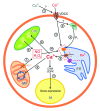Copper-induced intracellular calcium release requires extracellular calcium entry and activation of L-type voltage-dependent calcium channels in Ulva compressa
- PMID: 22751323
- PMCID: PMC3583951
- DOI: 10.4161/psb.20355
Copper-induced intracellular calcium release requires extracellular calcium entry and activation of L-type voltage-dependent calcium channels in Ulva compressa
Abstract
The marine alga Ulva compressa exposed to 10 µM copper showed a triphasic increase of intracellular calcium with maximal levels at 2, 3 and 12 h involving the activation of ryanodine-, Ins(1,4,5)P3- and NAADP-sensitive calcium channels. In order to analyze the requirement of extracellular calcium entry for intracellular calcium release as well as the activation of voltage-dependent calcium channels (VDCC) and phospholipase C, U. compressa was treated with EGTA, a non-permeable calcium chelating agent, with verapamil, nipfedipine and diltiazem, inhibitors of L-type VDCC, and with neomycin and U731222, inhibitors of phospholipase C. The release of intracellular calcium was partially inhibited with EGTA at 2 and 3 h and completely inhibited at 12 h of copper exposure and decreased with inhibitors of L-type VDCC and phospholipase C. Thus, copper-induced intracellular calcium release depends on calcium entry and activation of L-type VDCC and phospholipase C. An integrative model of copper-induced cellular responses in U. compressa is presented.
Figures




References
Publication types
MeSH terms
Substances
LinkOut - more resources
Full Text Sources
